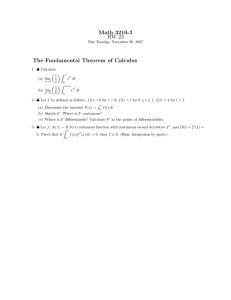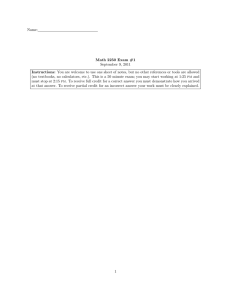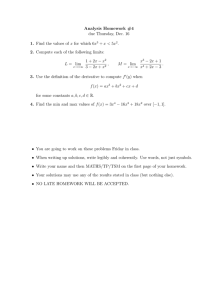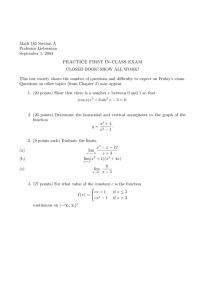Smoothing a Piecewise Polynomial
advertisement
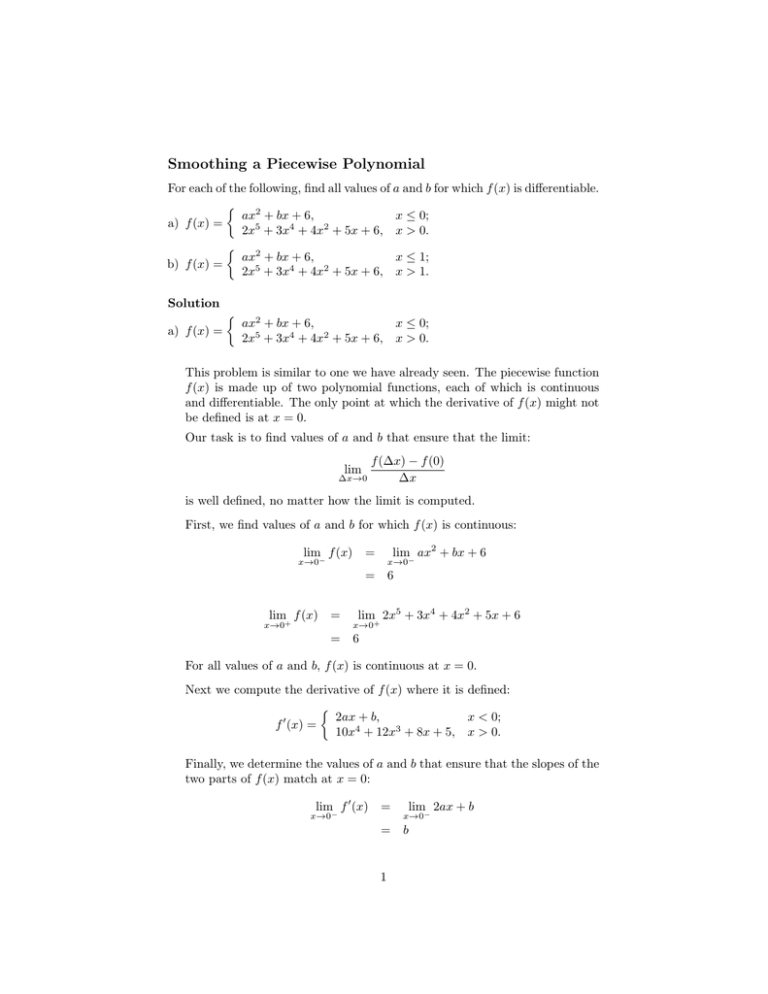
Smoothing a Piecewise Polynomial For each of the following, find all values of a and b for which f (x) is differentiable. ax2 + bx + 6, x ≤ 0; a) f (x) = 2x5 + 3x4 + 4x2 + 5x + 6, x > 0. ax2 + bx + 6, x ≤ 1; b) f (x) = 2x5 + 3x4 + 4x2 + 5x + 6, x > 1. Solution a) f (x) = ax2 + bx + 6, 2x5 + 3x4 + 4x2 + 5x + 6, x ≤ 0; x > 0. This problem is similar to one we have already seen. The piecewise function f (x) is made up of two polynomial functions, each of which is continuous and differentiable. The only point at which the derivative of f (x) might not be defined is at x = 0. Our task is to find values of a and b that ensure that the limit: lim ∆x→0 f (∆x) − f (0) ∆x is well defined, no matter how the limit is computed. First, we find values of a and b for which f (x) is continuous: lim f (x) lim ax2 + bx + 6 = x→0− x→0− = lim f (x) x→0+ = = 6 lim 2x5 + 3x4 + 4x2 + 5x + 6 x→0+ 6 For all values of a and b, f (x) is continuous at x = 0. Next we compute the derivative of f (x) where it is defined: 2ax + b, x < 0; 0 f (x) = 10x4 + 12x3 + 8x + 5, x > 0. Finally, we determine the values of a and b that ensure that the slopes of the two parts of f (x) match at x = 0: lim f 0 (x) x→0− = lim 2ax + b x→0− = b 1 lim f 0 (x) x→0+ = = lim 10x4 + 12x3 + 8x + 5 x→0+ 5 We conclude that when b = 5 and a is any real number, f (x) is differentiable. This makes sense; the two parts of the graph of f (x) always touch at (0, 6) and the constraint b = 5 is all that’s needed to ensure that their tangent lines have the same slopes at that point. b) f (x) = ax2 + bx + 6, 2x5 + 3x4 + 4x2 + 5x + 6, x ≤ 1; x > 1. The procedure for this part of the problem is the same as for the previous part. Because the definition of f (x) changes at x = 1, the requirement that f (x) be continuous now affects the values of a and b: lim f (x) lim ax2 + bx + 6 = x→1− x→1− = a+b+6 lim f (x) x→1+ = = lim 2x5 + 3x4 + 4x2 + 5x + 6 x→1+ 20. We conclude that f (x) is continuous whenever a + b + 6 = 20, or when a + b = 14. To determine where f is differentiable, we start by finding the slope of the 6 1: tangent line to the graph of f (x) at every point x = 2ax + b, x < 1; f 0 (x) = 10x4 + 12x3 + 8x + 5, x > 1. We could now substitute 14 − b for a. We choose not to for the sake of simplicity. lim f 0 (x) = x→1− = lim f 0 (x) x→1+ = = lim 2ax + b x→1− 2a + b lim 10x4 + 12x3 + 8x + 5 x→1+ 35 In order for f (x) to be differentiable, it must be continuous and the left hand and right hand limits of its derivative must match at x = 1. In other words: a + b = 14 2a + b = 35 2 Subtracting the first equation from the second, we find that a = 21 and b = −7. (We could get the same result by substituting 14 − b into the second equation for a and then solving for b.) We conclude that f (x) is differentiable when a = 21 and b = −7. We could check our work by graphing. 3 MIT OpenCourseWare http://ocw.mit.edu 18.01SC Single Variable Calculus Fall 2010 For information about citing these materials or our Terms of Use, visit: http://ocw.mit.edu/terms.
